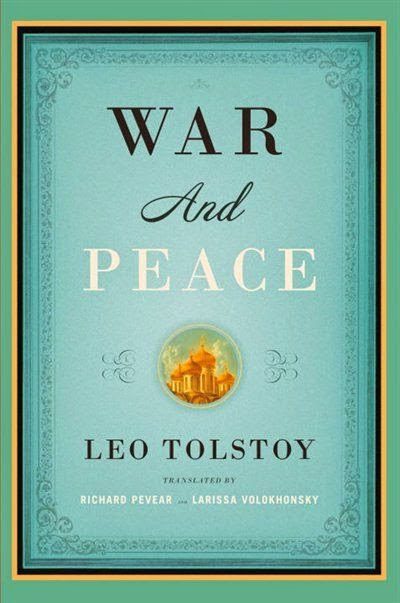On War & Peace: My Problems With The Pevear & Volokhonsky Translation (Part I)
 |
|
What are your thoughts on the Pevear and
Volokhonsky translation of Tolstoy’s
War and Peace?
|
I decided about a year ago that I’d like to re-read Tolstoy’s War and Peace every summer (this post may help to explain such madness).
The first two times I read the almighty tome, I picked up the Anthony Briggs translation that my grandmother gave me for Christmas when I was fifteen years old. And I absolutely loved it.
In the summer of 2012, I read it in twelve days; I couldn’t put it down, despite having read it before.
Fast forward to last summer, when I initially started with the Briggs translation once again. I was thoroughly enjoying it, but I couldn’t carry it on my travels (for fears of breaking my back, naturally).
To remedy a total lack of War and Peace, I downloaded the Pevear and Volokhonsky translation onto my Kindle, settled down to read it at the start of a long train journey across the UK, and turned my Kindle off less than fifteen minutes later. Most uncharacteristically, I spent the rest of the journey mostly staring out the window.
Was it me? Had I grown out of War and Peace, my favourite novel, all of a sudden? Surely not.
I tried continuing with the Pevear and Volokhonsky translation over and over again last summer, after relocating to Spain, but didn’t get anywhere. You, my poor readers, may well recall my frequent lamentations about my lack of progress with it.
After starting in August 2013, I had barely made a dent into Part III of Volume I by October, and shortly afterwards I gave it up altogether.
Needless to say, this translation clearly isn’t for me. But why? I decided to do some investigating.
Perhaps I didn’t enjoy the Pevear and Volokhonsky translation because…
- I found the writing awkward. It didn’t run smoothly and there were very few passages I felt like underlining, bookmarking or annotating.
- Anthony Briggs made it fun to read. I wasn’t finding this fun at all.
- It didn’t have the same magic or beauty that Briggs conveys.
- The ‘peace’ parts were nowhere near as engaging as Briggs makes them. Where was the exploration of ordinary life that I looked forward to?
- The French dialogue is kept, meaning you need to flick back and forth to find out what’s going on if you don’t speak the language (particularly tricky on a Kindle).
- Who on earth addresses a man as “my gentle”?!
Have you read Tolstoy’s War and Peace? Do you remember the translator of your edition, or have you tried several? Finally, what memories do you have of your reading experience?
Hold tight for Part II of this post and I’ll look at some side-by-side comparisons of the two translations. I’ll also have a think about whether Briggs is actually the translator to blame, as well as if I would have enjoyed it more in paperback.
You might also like:
- On War & Peace: My Problems With The Pevear & Volokhonsky Translation (Part II)
- What’s the best translation of War and Peace by Leo Tolstoy?
- Tips for Reading War and Peace & Getting Started with Leo Tolstoy
Enjoy more from me
- Retreat into my new book, Your Life in Bloom: Finding Your Path and Your Courage, Grounded in the Wisdom of Nature.
- I'm also the author of Mountain Song: A Journey to Finding Quiet in the Swiss Alps, a book about my time living alone by the mountains.
- If you love books, are feeling a little lost right now, and would love some gentle comfort and guidance, join The Sanctuary, my seven-day course to rebalance your life.
